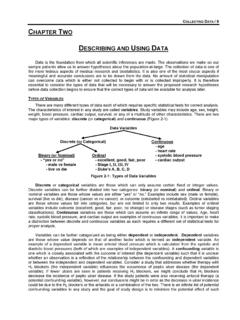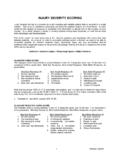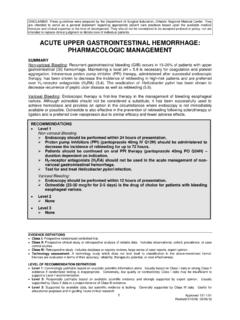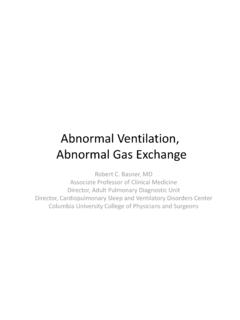Transcription of THE USE OF THROMBOLYTICS FOR PULMONARY EMBOLISM
1 DISCLAIMER: These guidelines were prepared by the Department of Surgical Education, Orlando Regional Medical Center. They are intended to serve as a general statement regarding appropriate patient care practices based upon the available medical literature and clinical expertise at the time of development. They should not be considered to be accepted protocol or policy, nor are intended to replace clinical judgment or dictate care of individual patients. THE USE OF THROMBOLYTICS IN THE INTENSIVE CARE UNIT FOR PULMONARY EMBOLISM SUMMARY The role of thrombolytic agents in the management of massive PULMONARY EMBOLISM (PE) is not well established.
2 Alteplase (recombinant tissue-plasminogen activator; rt-PA), streptokinase, and urokinase effectively restore PULMONARY blood flow when administered by the intravenous or intrapulmonary route. They have not been shown to improve mortality or long-term outcome and are associated with a significant risk of bleeding. THROMBOLYTICS should be reserved for patients with massive PE and evidence of cardiac dysfunction who have a low risk of bleeding. Intrapulmonary administration has not been consistently shown to be superior to intravenous dosing.
3 Administration of THROMBOLYTICS in the intensive care unit setting should be reserved for patients who are not stable for transport to the interventional radiology suite. Given the allergic reactions associated with streptokinase and long infusion duration of both streptokinase and urokinase, rt-PA is a reasonable first-line thrombolytic . RECOMMENDATIONS Level 1 Heparin is the drug of choice for PE (regardless of whether THROMBOLYTICS are used) if: No contraindications are present AND The anticipated benefit outweighs the risk in patients at high risk for bleeding Level 2 End-tidal carbon dioxide (ETCO2) measurements may be used to assess the efficacy of thrombolytic therapy.
4 Level 3 Consider intrapulmonary THROMBOLYTICS when urgent restoration of PULMONARY blood flow is necessary. Reserve administration of ICU THROMBOLYTICS for patients who meet the following criteria: Massive PE (obstruction of blood flow to a lobe or multiple segments of the lungs) AND Evidence of cardiac dysfunction AND Low bleeding risk AND Transfer to interventional radiology is not feasible Consider consultation with interventional radiology for mechanical intervention and/or possible thrombolysis. Fibrinogen levels may be used to monitor thrombolytic therapy.
5 INTRODUCTION The role of thrombolytic agents in the treatment of PE is not well established. THROMBOLYTICS clearly restore PULMONARY perfusion more rapidly than heparin alone and are associated with early hemodynamic improvement and reversal of right ventricular dysfunction. Improvements in mortality and long-term PULMONARY artery patency, however, have not been consistently demonstrated. The major disadvantage of thrombolytic therapy is serious bleeding, including intracranial hemorrhage. Heparin remains the cornerstone of therapy and THROMBOLYTICS are generally reserved for patients who are hemodynamically unstable and have a low risk of bleeding (1).
6 Intravenous administration is the FDA-approved route of drug delivery for rt-PA, streptokinase, and urokinase. Intrapulmonary infusion of these agents has been evaluated in several studies. The theoretical benefits of local administration include rapid achievement of peak concentrations at the thrombus and a decreased risk of systemic bleeding complications. 1 APPROVED 3/11/03 LITERATURE REVIEW The safety and efficacy of intravenous versus intrapulmonary rt-PA were evaluated in a multicenter European study of patients with massive bilateral PE (2).
7 After diagnosis was confirmed by PULMONARY angiography, intravenous (n=15) or intrapulmonary (n=19) rt-PA was given as a 10mg bolus followed by 20mg/hour over the first 2 hours. All patients received an intravenous bolus of 5000 IU heparin followed by a continuous infusion of 1000 IU/hour. Follow-up PULMONARY angiography was performed at the end of the 2-hour infusion period. If massive PE was present, a second infusion of 50mg rt-PA was given over 5 hours by the same route. Following rt-PA infusion, both groups had significant improvements in mean PULMONARY arterial pressure and PULMONARY angiographic severity score.
8 Intrapulmonary infusion did not offer a significant benefit over the intravenous route of administration. Forty-seven percent (16/34) developed some degree of bleeding, primarily at puncture and/or surgical sites. (Class I) Clot fragmentation combined with local fibrinolysis was performed in five patients with massive PE (3). All were fully heparinized during and after angiography. Local thrombolysis was achieved with an initial dose of 50-100mg rt-PA (a bolus of 14-20mg via the PULMONARY artery after clot fragmentation, followed by an intrapulmonary infusion over 2-5 hours through a pigtail catheter).
9 PULMONARY artery pressure significantly decreased following clot fragmentation and fibrinolysis. All patients survived and clinical improvement was noted within 24 hours. Bleeding complications occurred in 4/5 patients. Two experienced minor bleeding at the puncture site and 2 developed groin and retroperitoneal hematomas. Anticoagulation with heparin followed by coumadin was continued. (Class III) Four patients with massive PE were treated by thrombus fragmentation followed by local administration of rt-PA (4).
10 One patient received a low-dose regimen and is not discussed further. Following thrombus fragmentation, a bolus dose of 10-50mg was administered into the main PULMONARY artery or into the major branches of the right and left PULMONARY arteries. A continuous infusion of 10mg/hr was then initiated for 14-18 hours via the main PULMONARY artery. Heparin was administered at 1000 U/hr throughout thrombus fragmentation, rt-PA infusion, and until full anticoagulation with warfarin was achieved.
















